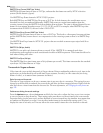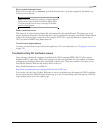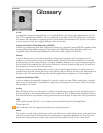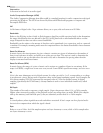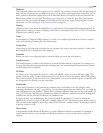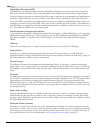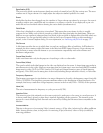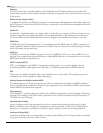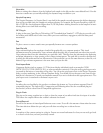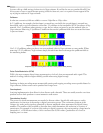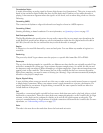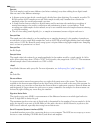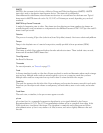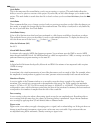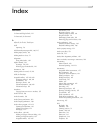
382
GLOSSARY APPENDIX B
Markers
Saved locations in the sound file. Markers can be displayed in the Trimmer window for sound files that
contain them, but more often, markers and regions are used at the project level to mark locations or sections
in the project.
Media Control Interface (MCI)
A standard way for Microsoft Windows programs t o communicate with multimedia devices like sound cards
and CD players. If a device has a MCI device driver, it can easily be controlled by most multimedia Microsoft
Windows software.
Media File
A media file, or multimedia file, is any image, audio or video file on a computer. In Vegas software, you can
browse for these files in the Explorer window. You can drag media files to the timeline or insert them into
the Project Media window. Media files that have been dragged to the timeline are referred to as events.
MIDI Clock
A MIDI device specific timing reference. It is not absolute time like MIDI timecode (MTC); instead, it is a
tempo-dependent number of ticks per quarter note. MIDI clock is convenient for synchronizing devices that
need to do tempo changes mid-song.
MIDI Port
A MIDI Port is the physical MIDI connection on a piece of MIDI gear. This port can be a MIDI in, out or
through. Your computer must have a MIDI port to output MIDI timecode to an external device or to receive
MIDI timecode from an external device.
MIDI Timecode (MTC)
MTC is an addendum to the MIDI 1.0 Specification and provides a way to specify absolute time for
synchronizing MIDI-capable applications. Basically, it is a MIDI representation of SMPTE timecode.
Mix
The process of combining multiple audio events and effects into a final output. The analogous process of
combining video events together is called compositing.
Musical Instrument Digital Interface (MIDI)
A standard language of control messages that provides for communication between any MIDI compliant
devices. Anything from synthesizers to lights to stage equipment can be controlled via MIDI. Vegas software
utilizes MIDI for synchronization purposes.
Noise-shaping
Noise-shaping is a technique that can minimize the audibility of quantization noise by shifting its frequency
spectrum. For example, in 44,100 Hz audio, quantization noise is shifted towards the Nyquist Frequency of
22,050 Hz. See also Dithering.
Nondestructive Editing
A type of editing used by Vegas software that involves a pointer-based system of keeping track of edits.
When you delete a section of audio in a nondestructive system, the audio on disk is not actually deleted.
Instead, a set of pointers is established to tell the program to play the active sections during playback.
Nonlinear Editing (NLE)
A method of editing video non-sequentially or in random order. Editing video in Vegas software is nonlinear
as opposed to editing video tape, which is linear.



